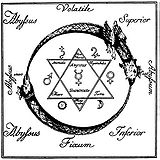Macrocosm
Macrocosm ("big world", from Greek makrós "big" and kósmos "world", Latin macrocosmus or maior mundus ) is the opposite of microcosm ("small world"). It is understood to mean the world as a whole, insofar as it is understood from a philosophical or religious point of view as an ordered, self-contained unit - as a cosmos . The “microcosm” is then a delimited part of the macrocosm that has a certain relationship to the whole, for example in a similarity or analogy relationship.
In numerous religious or philosophical teachings, the microcosm is viewed as an image of the macrocosm. Such theories are usually based on the assumption that the "small world" - for example the earth, a state or a living being - repeats the structure of the universe on a small scale, that is, mirrors the "big world". The human being or his body is particularly often considered a microcosm in this sense, so the macrocosm / microcosm thought is an important part of many anthropological concepts. It is often asserted that the microcosm is built up from the same elements as the macrocosm. Behind this is the idea of an all-encompassing world order, a cosmos that is harmoniously ordered and therefore beautiful throughout according to uniform principles.

In such a world model, conclusions by analogy from one part to the whole or vice versa are fundamentally possible. Following this consideration, numerous medieval thinkers regarded man as a principle of knowledge: They believed that in man's self-knowledge, there is at the same time a knowledge of everything that is at all; whoever correctly understands the microcosm also understands the macrocosm at the same time. This thesis was put forward by some philosophers in the sense of a "real correspondence", that is, according to a strong interpretation. This means that in the microcosm the natures of all things are given, man really includes all substances of the macrocosm. According to weaker versions, it is only a correspondence “in a certain way”, an analogy between man and the world.
In Goethe's Faust (Part 1) as well as in Urfaust , Faust mentions the symbol of the macrocosm in the monologue . In the middle of the sign is Mercury , around the outside there are Venus , Mars , Jupiter , Saturn , Sun and Moon .
literature
- Matthias Gatzemeier , Helmut Holzhey : Macrocosm / Microcosm . In: Historical Dictionary of Philosophy . Volume 5, Schwabe, Basel 1980, Sp. 640-649
- Günter Lanczkowski, Wolfgang Janke, Georg Siegmann: Macrocosm / Microcosm . In: Theological Real Encyclopedia . Volume 21, de Gruyter, Berlin / New York 1991, ISBN 3-11-012952-3 , pp. 745-754
- Ulrike Mörschel: Macrocosm / Microcosm . In: Lexicon of the Middle Ages . Volume 6, Artemis & Winkler, Munich 1993, ISBN 3-7608-8906-9 , Sp. 157-159
Web links
Remarks
- ↑ See for the different models Theodor W. Köhler : Basics of the philosophical-anthropological discourse in the thirteenth century , Leiden 2000, pp. 487-522.